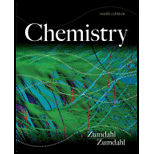
Concept explainers
(a)
Interpretation: Some facts about photography lens are given. The answers are to be stated as per the given conditions.
Concept introduction: Photography lenses contain silver chloride. Silver chloride is light sensitive.
To determine: The explanation for the difference in the fact that, when the light is removed from the decomposition reaction of white silver chloride, the reverse reaction occurs but when pure white silver chloride is exposed to sunlight it darkens and the reverse reaction does not occur in the dark.
(b)
Interpretation: Some facts about photography lens are given. The answers are to be stated as per the given conditions.
Concept introduction: Photography lenses contain silver chloride. Silver chloride is light sensitive.
To determine: An explanation for the reason that, photography lenses do become permanently dark in time.
Trending nowThis is a popular solution!

Chapter 20 Solutions
Chemistry
- Iron(II) ion undergoes a disproportionation reaction to give Fe(s) and the iron(III) ion. That is, iron(II) ion is both oxidized and reduced within the same reaction. 3 Fe2+(aq) Fe(s) + 2 Fe3+(aq) (a) What two half-reactions make up the disproportionation reaction? (b) Use the values of the standard reduction potentials for the two half-reactions in part (a) to determine whether this disproportionation reaction is product-favored at equilibrium. (c) What is the equilibrium constant for this reaction?arrow_forwardThe photographs below (a) show what occurs when a solution of iron(III) nitrate is treated with a few drops of aqueous potassium thiocyanate. The nearly colorless iron(III) ion is converted to a red [Fe(H2O)5SCN)2+ ion. (This is a classic test for the presence of iron(III) ions in solution.) [Fe(H2O)6]3+(aq) + SCN(aq) [Fe(H2O)5SCN]2+(aq) + H2O() (a) As more KSCN is added to the solution, the color becomes even more red. Explain this observation. (b) Silver ions form a white precipitate with SCN ions. What would you observe on adding a few drops of aqueous silver nitrate to a red solution of [Fe(H2O)5 SCN]+ ions? Explain your observation.arrow_forwardCopper(I) ion disproportionates to copper metal and copper(ll) ion. (See Study Question 99.) 2 Cu+(aq) Cu(s) + Cu2 + (aq) (a) What two half-reactions make up the disproportionation reaction? (b) Use values of the standard reduction potentials for the two half-reactions in part (a) to determine whether this disproportionation reaction is product-favored at equilibrium. (c) What is the equilibrium constant for this reaction? If you have a solution that initially contains 0.10 mol of Cu+ in 1.0 L of water, what are the concentrations of Cu+ and Cu2+ at equilibrium?arrow_forward
- Comparing the chemistry of carbon and silicon. (a) Write balanced chemical equations for the reactions of H2O() with CH4 (forming CO2 and H2) and SiH4 (forming SiO2 and H2). (b) Using thermodynamic data, calculate the standard free energy change for the reactions in (a). Is either reaction product-favored at equilibrium? (c) Look up the electronegativities of carbon, silicon, and hydrogen. What conclusion can you draw concerning the polarity of CH and SiH bonds? (d) Carbon and silicon compounds with the formulas (CH3)2CO (acetone) and [(CH3)2SiO]n (a silicone polymer) also have quite different structures. Draw Lewis structures for these species. This difference, along with the difference between structures of CO2 and SiO2, suggests a general observation about silicon compounds. Based on that observation, do you expect that a silicon compound with a structure similar to ethene (C2H4) exists?arrow_forwardUsing the thermodynamic information in the ALEKS Data tab, calculate the standard reaction free energy of the following chemical reaction: 2NH3(g)→N2H4(g)+H2(g)arrow_forwardFor (a.) Al3+|Al, (b.) Cu2+|Cu, (c.) Li+|Li, (d.) Cd2+|Cd, (e.) Au3+|Au Given redox couples, determine the temperature at which the redox couples are in equilibrium considering under standard conditions: 25 °C 1 M concentration for each ion participating in the reaction The partial pressure of 1 atm for each gas that is part of the reactionarrow_forward
 Chemistry & Chemical ReactivityChemistryISBN:9781133949640Author:John C. Kotz, Paul M. Treichel, John Townsend, David TreichelPublisher:Cengage Learning
Chemistry & Chemical ReactivityChemistryISBN:9781133949640Author:John C. Kotz, Paul M. Treichel, John Townsend, David TreichelPublisher:Cengage Learning Chemistry & Chemical ReactivityChemistryISBN:9781337399074Author:John C. Kotz, Paul M. Treichel, John Townsend, David TreichelPublisher:Cengage Learning
Chemistry & Chemical ReactivityChemistryISBN:9781337399074Author:John C. Kotz, Paul M. Treichel, John Townsend, David TreichelPublisher:Cengage Learning Chemistry: The Molecular ScienceChemistryISBN:9781285199047Author:John W. Moore, Conrad L. StanitskiPublisher:Cengage Learning
Chemistry: The Molecular ScienceChemistryISBN:9781285199047Author:John W. Moore, Conrad L. StanitskiPublisher:Cengage Learning Chemistry for Engineering StudentsChemistryISBN:9781337398909Author:Lawrence S. Brown, Tom HolmePublisher:Cengage Learning
Chemistry for Engineering StudentsChemistryISBN:9781337398909Author:Lawrence S. Brown, Tom HolmePublisher:Cengage Learning General Chemistry - Standalone book (MindTap Cour...ChemistryISBN:9781305580343Author:Steven D. Gammon, Ebbing, Darrell Ebbing, Steven D., Darrell; Gammon, Darrell Ebbing; Steven D. Gammon, Darrell D.; Gammon, Ebbing; Steven D. Gammon; DarrellPublisher:Cengage Learning
General Chemistry - Standalone book (MindTap Cour...ChemistryISBN:9781305580343Author:Steven D. Gammon, Ebbing, Darrell Ebbing, Steven D., Darrell; Gammon, Darrell Ebbing; Steven D. Gammon, Darrell D.; Gammon, Ebbing; Steven D. Gammon; DarrellPublisher:Cengage Learning





